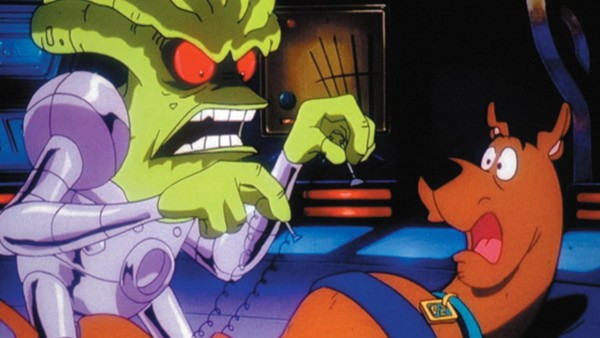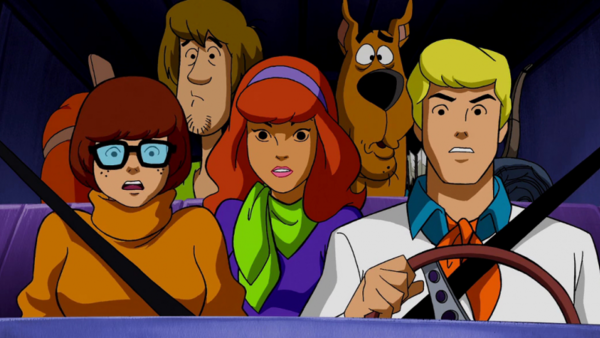What If Scooby Doo Is Actually An Escaped Cold War Experiment?
And he got away with it too, thanks to those meddling kids.

Scooby Doo is unarguably a cultural icon. Born in the late 60s to Hanna-Barbera in the heyday of their cartoon monopoly, Scooby Doo was created to invigorate Saturday morning television, portraying the adventures of a group of teenagers that travel the world solving mysteries, and soon spawned into a five-decade strong franchise.
With a psychedelic van, talking dog, and a serious case of the munchies, one can be forgiven for assuming the whole thing is Shaggy tripping off his balls whilst he lives his best hippie life in the back of a broken down camper. And whilst edibles could be the explanation for a lot of weird things in life, this particular children’s adventure has a more age-appropriate origin story: our loveable Scoobert is a genetically engineered Cold War monstrosity on the run from his past. Wait, what?
Of course, the internet is to blame for this wild fan theory, with user TheMightyHeptagon of Reddit notoriety bringing us this insane slice of a Scooby Doo thinkpiece. With the evidence slotting in neatly to the TV show’s themes and particularly reflective of the time of its release, there’s some weight to the theory that is, at the very least, pretty entertaining.
As a starting point - the release date of the original Scooby Doo series is the foundation from which the theory is built. Originally airing as What’s New, Scooby Doo! in 1969, when the Cold War was in the middle of its wind-down, it was this same year that the USA finally realised its dream of putting a man on the moon.
Since 1957 however, the Soviet Space Agency had been going strong. Much stronger than America, in fact. Launching the first artificial satellite in the form of Sputnik that year and making Yuri Gagarin the first man in space in 1961, the Soviets were soon mastering the art of strapping things to a rocket and sending them into orbit - but like all good things in life, it all started with dogs.
Laika was one of the first - a stray from the streets of Moscow that was taken, bundled into a little metal cube and shot off out of our atmosphere as a precursory test to trialing humans. With no way of bringing her back and inadequate technology to ensure her survival, she died of overheating not long after launch. In 1960, the Soviets managed to solve their murderous dog-dealing ways - shooting Belka and Strelka into orbit and successfully bringing them back alive. Undoubtedly, there were plenty more live test subjects in between.

So, how does Scooby fit into all of this, you ask? Well, what can Scooby Doo do that our regular earth dogs can’t manage unless they’re being offered maple bacon from the meat drawer? That’s right - talk. A test subject that can communicate with scientists down on earth, as well as complete basic tasks like sandwich building and dressing like a lampshade, would be invaluable to a team trying to understand the complexities of space travel.
It makes sense that to be able to further understand their mission, the Soviets would experiment on dogs (just as they had been already in using them as space fodder) to genetically engineer an animal that could help with data in more ways than simply inhabiting the shuttle. An intelligent dog would still be preferable to losing a fully trained astronaut, and easy enough to replace once they'd developed a reliable breed.
Yes, this is reaching, and yes, lots of this is based on speculation, but it’s a theory goddamnit, and we’re going to run with it. Just like Scooby did away from his lab-rat existence and into the open arms of America.
Maybe it was a scientist who bonded with the puppy and defected to the United States, maybe it was an American spy who stole the subject for scientific gain but couldn’t quite commit to experimenting on a dog that could tell them exactly how it feels, releasing him to be adopted by Shaggy, or maybe it was something even more ludicrous. Maybe Shaggy lived up to his hippie stylings and freed Scooby as an animal rights protester upon learning of the dying dog pilots being sent to space.
Either way, Scoob ended up joining Mystery Inc with his equally hungry pal to put his superior animal intellect to good use, solving ‘supernatural’ crimes up and down the country. The evidence doesn’t stop there, however. Have you ever noticed that the Mystery Machine almost always begins by driving with no set path? It’s almost like the gang are constantly on the move, running and hiding from potential threats that would take their scientific government property away.
It would also explain the enigmatic title of Scooby Doo, Where Are You!, as the gang is never unsure of the dog’s whereabouts - but a lost Soviet super-dog would call for some searching.

Other evidence further ties into the Soviet Space Agency theory, such as Scooby Doo’s breed itself. Stylised as a Great Dane, the dog breed is actually German, which is important when related back to the Germans being the prime researchers into rocket technology during WW2. Because of this, many of the Soviet Space Agency scientists were German-born and recruited for their knowledge - perhaps bringing their pets along with them.
Interestingly, Scooby’s depiction as a Great Dane is one that defies the standard appearance of the breed. The artist who designed the dog, Iwao Takamoto, purposely altered his Great Dane drawings to create the Scooby we know, giving him a large double chin in place of a strong one, bowed legs instead of straight, and a spotted coat instead of even-toned. All these subverted qualities could have been chosen to indicate a breed that has been tampered with: aka, genetically altered. It wouldn’t matter what features make a pure-bred Great Dane as the scientists would be looking for genes that create intelligence, perhaps resulting in a substandard breed that doesn’t quite fit the look or even sound quite right.
On that note, Scooby’s speech impediment is another indication of testing, as he would be designed to understand human communications and carry them out during space test, but not necessarily to converse back. The lack of precision in his speech has come about as he’s been taught human words with a mouth not designed to speak our language, resulting in the famous ‘r’ heavy dialogue.
From another perspective, then, A Pup Named Scooby Doo is one of the only pieces of canonical content that could deride this theory, portraying Scooby and the gang's childhoods together in whimsical fancy. But there’s explanations for that too. It could simply portray the youth of the character after his brief time in the facility as he’s now with a new family; or, in a much darker version of events, act as a hallucinatory dream sequence of the childhood he wishes he had whilst being imprisoned for animal testing. Poor Scooby.
Even the god-awful Scrappy ties in. He speaks more clearly, is smaller and more nimble, and has a much stronger sense of initiative, even if this does come through as him being a f*cking annoying pr*ck. He’s the result of further honed breeding programmes to create a more perfect animal to take into space: it’s just a shame they couldn’t shoot him up there and forget about him altogether.
So there you have it. All the evidence you could need to read between the lines of Scooby Doo and find a much darker subplot - one where Cold War secrets run rife, animals are nothing but tools for science, and four teenagers are the sole protectors of the world's most intelligent canine.
And there you were thinking it was just about a talking dog!